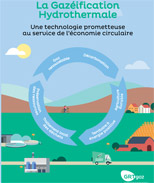Initial study on the potential of hydrothermal gasification in France
In complement to the anaerobic digestion and pyro-gasification sectors, hydrothermal gasification alone could provide renewable gas production of between 58 TWh and 138 TWh per year by 2050; i.e. up to one-third of future French gas consumption. It offers an effective solution for reducing the amount of final waste and developing the circular economy.
A promising technology for waste that is poorly or insufficiently recovered
Hydrothermal gasification uses a high-pressure (250 to 300 bar) and high-temperature (400 to 700°C) thermochemical method to process and convert liquid organic waste with a low dry matter content (between 5 and 25%) into a renewable gas. Of the nearly 40 possible deposits analysed in the study, GRTgaz has identified four categories of input that are particularly relevant for hydrothermal gasification in France: sludge from wastewater treatment plants; digestates from anaerobic digestion units; organic effluents from industrial activities; and liquid effluents from livestock.
Significant potential to contribute to France’s renewable gas mix
The study of liquid biomass deposits generated in France (from liquid waste and residues) shows a potential of at least 340 million tonnes/year, of which around 100 million tonnes/year can already be utilized. Assumptions for utilizing these reserves indicate that the potential for renewable gas from this technology could be between 58 and 138 TWh per year by 2050. The first operational facilities could be up and running in France as early as 2025.
A complementary solution for other innovative renewable gas production sectors
Depending on the local input and ecosystem, hydrothermal gasification can be a complementary or alternative technology to anaerobic digestion or pyro-gasification. It can recover digestates downstream of agricultural anaerobic digestion units or wastewater treatment plants, and could play a key role in managing the large volumes generated by the development of this sector. Hydrothermal gasification can also become an alternative to anaerobic digestion in conditions where there are constraints on the recovery of digestates (for example, where there is a lack of spreading surface). As for pyro-gasification for solid waste, it offers a recovery option for liquid biomass waste that avoids incineration and/or landfill. Hydrothermal gasification aligns perfectly with sustainable development, the circular economy, the bioeconomy, and the drastic reduction of final waste and residues in territories, cities and agglomerations.
Publication
